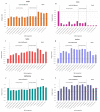NMR-Based Metabolomic Study on Phaseolus vulgaris Flour Fermented by Lactic Acid Bacteria and Yeasts
- PMID: 37375419
- PMCID: PMC10302956
- DOI: 10.3390/molecules28124864
NMR-Based Metabolomic Study on Phaseolus vulgaris Flour Fermented by Lactic Acid Bacteria and Yeasts
Abstract
In recent years, fermented foods have attracted increasing attention due to their important role in the human diet, since they supply beneficial health effects, providing important sources of nutrients. In this respect, a comprehensive characterization of the metabolite content in fermented foods is required to achieve a complete vision of physiological, microbiological, and functional traits. In the present preliminary study, the NMR-based metabolomic approach combined with chemometrics has been applied, for the first time, to investigate the metabolite content of Phaseolus vulgaris flour fermented by different lactic acid bacteria (LAB) and yeasts. A differentiation of microorganisms (LAB and yeasts), LAB metabolism (homo- and heterofermentative hexose fermentation), LAB genus (Lactobacillus, Leuconostoc, and Pediococcus), and novel genera (Lacticaseibacillus, Lactiplantibacillus, and Lentilactobacillus) was achieved. Moreover, our findings showed an increase of free amino acids and bioactive molecules, such as GABA, and a degradation of anti-nutritional compounds, such as raffinose and stachyose, confirming the beneficial effects of fermentation processes and the potential use of fermented flours in the production of healthy baking foods. Finally, among all microorganisms considered, the Lactiplantibacillus plantarum species was found to be the most effective in fermenting bean flour, as a larger amount of free amino acids were assessed in their analysis, denoting more intensive proteolytic activity.
Keywords: NMR; Phaseolus vulgaris; chemometrics; common bean; fermentation; lactic acid bacteria; legumes; metabolomics.
Conflict of interest statement
The authors declare no conflict of interest.
Figures






Similar articles
-
Molecular identification and technological characterization of lactic acid bacteria isolated from fermented kidney beans flours (Phaseolus vulgaris L. and P. coccineus) in northwestern Argentina.Food Res Int. 2017 Dec;102:605-615. doi: 10.1016/j.foodres.2017.09.042. Epub 2017 Sep 20. Food Res Int. 2017. PMID: 29195991
-
Lactic acid fermentation improves nutritional and functional properties of chickpea flours.Food Res Int. 2025 Feb;203:115899. doi: 10.1016/j.foodres.2025.115899. Epub 2025 Jan 31. Food Res Int. 2025. PMID: 40022406
-
Biodiversity and technological potential of lactic acid bacteria isolated from spontaneously fermented amaranth sourdough.Lett Appl Microbiol. 2016 Aug;63(2):147-54. doi: 10.1111/lam.12604. Lett Appl Microbiol. 2016. PMID: 27282128
-
Review - Lactic acid bacteria in traditional fermented Asian foods.Pak J Pharm Sci. 2017 Sep;30(5):1803-1814. Pak J Pharm Sci. 2017. PMID: 29084705 Review.
-
Impact of lactic acid bacteria and their metabolites on the techno-functional properties and health benefits of fermented dairy products.Crit Rev Food Sci Nutr. 2023;63(21):4819-4841. doi: 10.1080/10408398.2021.2007844. Epub 2021 Nov 30. Crit Rev Food Sci Nutr. 2023. PMID: 34845955 Review.
Cited by
-
Role of Lactic Acid Bacteria in Insecticide Residue Degradation.Probiotics Antimicrob Proteins. 2025 Feb;17(1):81-102. doi: 10.1007/s12602-024-10298-0. Epub 2024 May 31. Probiotics Antimicrob Proteins. 2025. PMID: 38819541 Review.
-
Using metabolomics to understand stress responses in Lactic Acid Bacteria and their applications in the food industry.Metabolomics. 2023 Nov 24;19(12):99. doi: 10.1007/s11306-023-02062-2. Metabolomics. 2023. PMID: 37999908 Review.
-
Revisiting microbial exopolysaccharides: a biocompatible and sustainable polymeric material for multifaceted biomedical applications.3 Biotech. 2024 Apr;14(4):95. doi: 10.1007/s13205-024-03946-3. Epub 2024 Mar 4. 3 Biotech. 2024. PMID: 38449708 Free PMC article. Review.
References
-
- Rai A.K., Jeyaram K. Role of Yeasts in Food Fermentation. In: Satyanarayana T., Kunze G., editors. Yeast Diversity in Human Welfare. Springer; Singapore: 2017. - DOI
MeSH terms
Substances
Grants and funding
LinkOut - more resources
Full Text Sources
Miscellaneous

